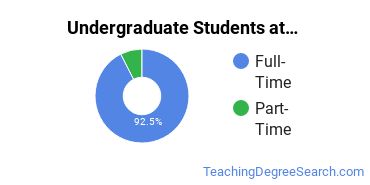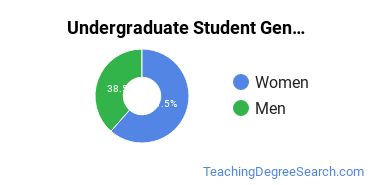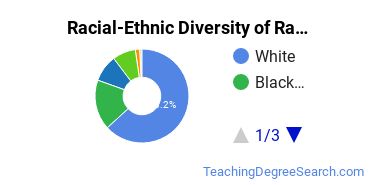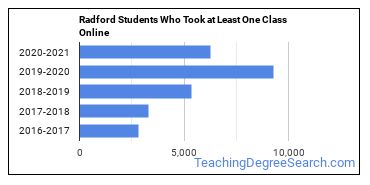Radford University Teaching Programs
Located in Radford, Virginia, Radford University is a public institution. Radford is considered a suburb and offers tranquility and safety near the excitement of a city center.
Featured schools near , edit
Where Is Radford University?

Contact details for Radford are given below.
| Contact Details | |
|---|---|
| Address: | 801 East Main St., Radford, VA 24142 |
| Phone: | 540-831-5000 |
| Website: | www.radford.edu |
How Do I Get Into Radford?
You can apply to Radford online at: https://www.radford.edu/apply
Admission Requirements for Radford
| Submission | Required? |
|---|---|
| High School GPA | 1 |
| High School Rank | 5 |
| High School Transcript | 1 |
| College Prep Program | 5 |
| Recommendations | 5 |
| SAT or ACT Scores | 5 |
| TOEFL | 1 |
How Hard Is It To Get Into Radford?
Approximately 36% of accepted students are men and 64% are women. The acceptance rate for men is 93%, and the acceptance rate for women is 94%.
Average Test Scores
About 26% of students accepted to Radford submitted their SAT scores. When looking at the 25th through the 75th percentile, SAT Evidence-Based Reading and Writing scores ranged between 490 and 600. Math scores were between 470 and 560.
Can I Afford Radford University?
The net price is calculated by adding tuition, room, board and other costs and subtracting financial aid.
Student Loan Debt
While almost two-thirds of students nationwide take out loans to pay for college, the percentage may be quite different for the school you plan on attending. At Radford, approximately 67% of students took out student loans averaging $7,385 a year. That adds up to $29,540 over four years for those students.
Radford University Undergraduate Student Diversity

There are also 2,485 graduate students at the school.
Gender Diversity
Of the 6,024 full-time undergraduates at Radford, 39% are male and 61% are female.

Racial-Ethnic Diversity
The racial-ethnic breakdown of Radford University students is as follows.

| Race/Ethnicity | Number of Grads |
|---|---|
| Asian | 90 |
| Black or African American | 1,040 |
| Hispanic or Latino | 481 |
| White | 3,806 |
| International Students | 49 |
| Other Races/Ethnicities | 558 |
Geographic Diversity
Virginia students aren't the only ones who study at Radford University. At this time, 24 states are represented by the student population at the school.
Over 39 countries are represented at Radford. The most popular countries sending students to the school are Saudi Arabia, Canada, and China.
Online Learning at Radford University
The following chart shows how the online learning population at Radford has changed over the last few years.

This school is the 7th most popular in Virginia for online learning according to the online graduations recorded by the Department of Education for the academic year 2022-2023.
The following table shows the 1-year growth rate of Radford majors that offer at least one online course. This table only includes majors with positive growth.
| Major | 1-Year Growth Rate |
|---|---|
| Mathematics Education | 27% |
Radford University Teaching Concentrations
The table below shows the number of awards for each concentration.
| Major | Bachelor’s | Graduate Certificate | Master’s | TOTAL |
|---|---|---|---|---|
| Physical Education Teaching & Coaching | 84 | 0 | 0 | 84 |
| General Special Education | 0 | 0 | 51 | 51 |
| Counselor Education/School Counseling & Guidance Services | 0 | 0 | 39 | 39 |
| General Education | 0 | 0 | 31 | 31 |
| General Educational Leadership & Administration | 0 | 0 | 23 | 23 |
| Mathematics Education | 0 | 11 | 0 | 11 |
| Reading Teacher Education | 0 | 0 | 11 | 11 |
| Education/Teaching of Individuals with Autism | 0 | 3 | 0 | 3 |
| TOTAL | 84 | 14 | 155 | 253 |
References
*The racial-ethnic minorities count is calculated by taking the total number of students and subtracting white students, international students, and students whose race/ethnicity was unknown. This number is then divided by the total number of students at the school to obtain the racial-ethnic minorities percentage.
- College Factual
- National Center for Education Statistics
- Image Credit: By Matt under License
More about our data sources and methodologies.
Featured Schools
 Request Info
Request Info
|
Southern New Hampshire University You have goals. Southern New Hampshire University can help you get there. Whether you need a bachelor's degree to get into a career or want a master's degree to move up in your current career, SNHU has an online program for you. Find your degree from over 200 online programs. Learn More > |
